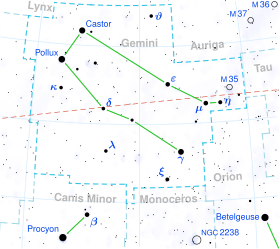
Back 57 Geminorum AST 57 dels Bessons Catalan 57 Geminorum Spanish 57 Geminorum Portuguese 57 Близнецов Russian 57 Geminorum Swedish 天樽一 Chinese
| Observation data Epoch J2000.0 Equinox J2000.0 | |
|---|---|
| Constellation | Gemini |
| Right ascension | 07h 23m 28.511s[1] |
| Declination | +25° 03′ 01.91″[1] |
| Apparent magnitude (V) | 5.018[2] |
| Characteristics | |
| Spectral type | G8III[3] |
| U−B color index | +1.778[2] |
| B−V color index | +0.174[2] |
| Astrometry | |
| Radial velocity (Rv) | 5.43±0.13[1] km/s |
| Proper motion (μ) | RA: −66.676[1] mas/yr Dec.: −29.082[1] mas/yr |
| Parallax (π) | 18.1774 ± 0.1459 mas[1] |
| Distance | 179 ± 1 ly (55.0 ± 0.4 pc) |
| Absolute magnitude (MV) | 1.66[4] |
| Details | |
| Mass | 2.2[5] M☉ |
| Radius | 7.1[1] R☉ |
| Luminosity | 29[1] L☉ |
| Surface gravity (log g) | 2.84[4] cgs |
| Temperature | 4,902[4] K |
| Metallicity [Fe/H] | 0.21[4] dex |
| Rotational velocity (v sin i) | 1.3[6] km/s |
| Age | 1.2[7] Gyr |
| Other designations | |
| Database references | |
| SIMBAD | data |
57 Geminorum (57 Gem) is a yellow giant star in the constellation Gemini, with an apparent magnitude of 5.0. At a distance of about 179 light years, it has a luminosity about 29 times the Sun's. With an age of about 1.2 billion years, it has evolved away from the main sequence and expanded to seven times the width of the Sun.
57 Geminorum is the star's Flamsteed designation. It also has the rarely-used Bayer designation A Geminorum.
The radial velocity of 57 Geminorum has been closely examined for indications that it may have orbiting exoplanets, but it shows a particularly stable radial velocity.[8][9]
- ^ a b c d e f g h Cite error: The named reference
dr3was invoked but never defined (see the help page). - ^ a b c Cite error: The named reference
paunzen2022was invoked but never defined (see the help page). - ^ Cite error: The named reference
harlan1969was invoked but never defined (see the help page). - ^ a b c d Cite error: The named reference
schiavon2007was invoked but never defined (see the help page). - ^ Cite error: The named reference
starhorsewas invoked but never defined (see the help page). - ^ Cite error: The named reference
glebocki2005was invoked but never defined (see the help page). - ^ Cite error: The named reference
takeda2008was invoked but never defined (see the help page). - ^ Cite error: The named reference
sato2005was invoked but never defined (see the help page). - ^ Cite error: The named reference
isaacson2010was invoked but never defined (see the help page).
